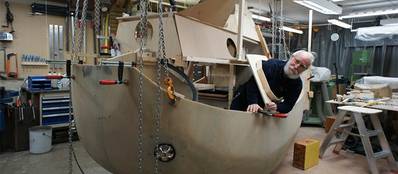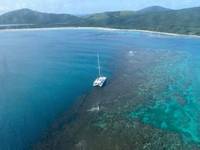Yrvind Prepares for World Record Sailing Attempt
What would you do with 600 days alone at sea? While most may say they would go crazy, Sven Yrvind of Sweden cannot wait to get started. Supplied simply with muesli, powdered milk and sardines along with a couple hundred pounds of books as familiar company, the 75-year-old plans to break a world record. His goal is to sail solo non-stop around the world with the smallest vessel ever, the Yrvind Ten – a 10-foot, 1½-ton boat he has built himself using DIAB Divinycell composites.
“The last big ridiculous challenge of sailing”
Sven Yrvind seems to have always had the sea in his life. He grew up on a small island in the North Sea while his grandfather was Captain and his father First Mate on a Swedish cargo ship. Born Sven Lundin in 1939, he later changed his name to Yrvind, reflecting the intense “whirlwind” of a gale at sea. After struggling early in his life, he found his purpose and passion in building boats by age 23. One of his first is on display in the Museum of Yachting’s Hall of Fame for single-handed sailors in New England.
Now, 50 years later, he is not preparing for retirement but for his biggest challenge yet – sailing around the world in a ten-foot boat. Estimated to take about 600 days, this will be his longest voyage alone at sea.
-People say it’s impossible. Who cares? It is not the first time people have discouraged me, Sven Yrvind laughs. And true, he is no stranger to remarkable solo achievements. Nearly 35 years ago, the UK’s Royal Cruising Club granted him the Seamanship Medal for sailing a 20-foot boat alone through the notoriously tempestuous waters off Cape Horn. His coming endeavor will take him through those waters again. That is why he is taking no chances in constructing the Yrvind Ten.
Composite construction is crucial in rough seas
Decades of experience, research and intuition have given Sven Yrvind unique expertise in boat building. He knows it is not a question of if, but when the boat will capsize, strike something at sea, or otherwise be put to the test. However, he believes there is no reason to fear the sea. On the contrary, he finds it safer than land — as long as one is smart and prepared.
As for Divinycell, he’s hardly a novice. He has been building boats using DIAB composites since the 1980s and to be honest, he finds it child’s play. His very first Divinycell-boat, with the centerboard uniquely placed in front of the mast, can today be seen at the Maritime Museum in Stockholm.
Using Divinycell H100 makes the boat very strong, lightweight, well-insulated and practically unsinkable, qualities that Captain Yrvind likes. The hull itself is made of small tiles, or quadrangles of Divinycell that are glued together and laminated. Secure in his proven boat-building skills and the sturdy Divinycell composite construction, Yrvind knows he can meet the challenges ahead.
Making better use of limited resources
Although sociable with friends and visitors alike, Sven Yrvind welcomes the time alone at sea.
–Unlike other sailors, I am not in a hurry, he writes on his blog. But it will not be easy. That is the point. For me there is absolutely nothing worth doing as much as solving problems.
He finds that he is healthier, clearer of mind, and stronger after his voyages. He also hopes that his journey can teach others to reevaluate their priorities and take steps to reduce our consumption of resources. Living over a year and a half at sea in a space little bigger than a bathtub, Sven Yrvind intends to demonstrate that we can achieve great things while consuming less. We at DIAB are privileged to be part of his journey.





